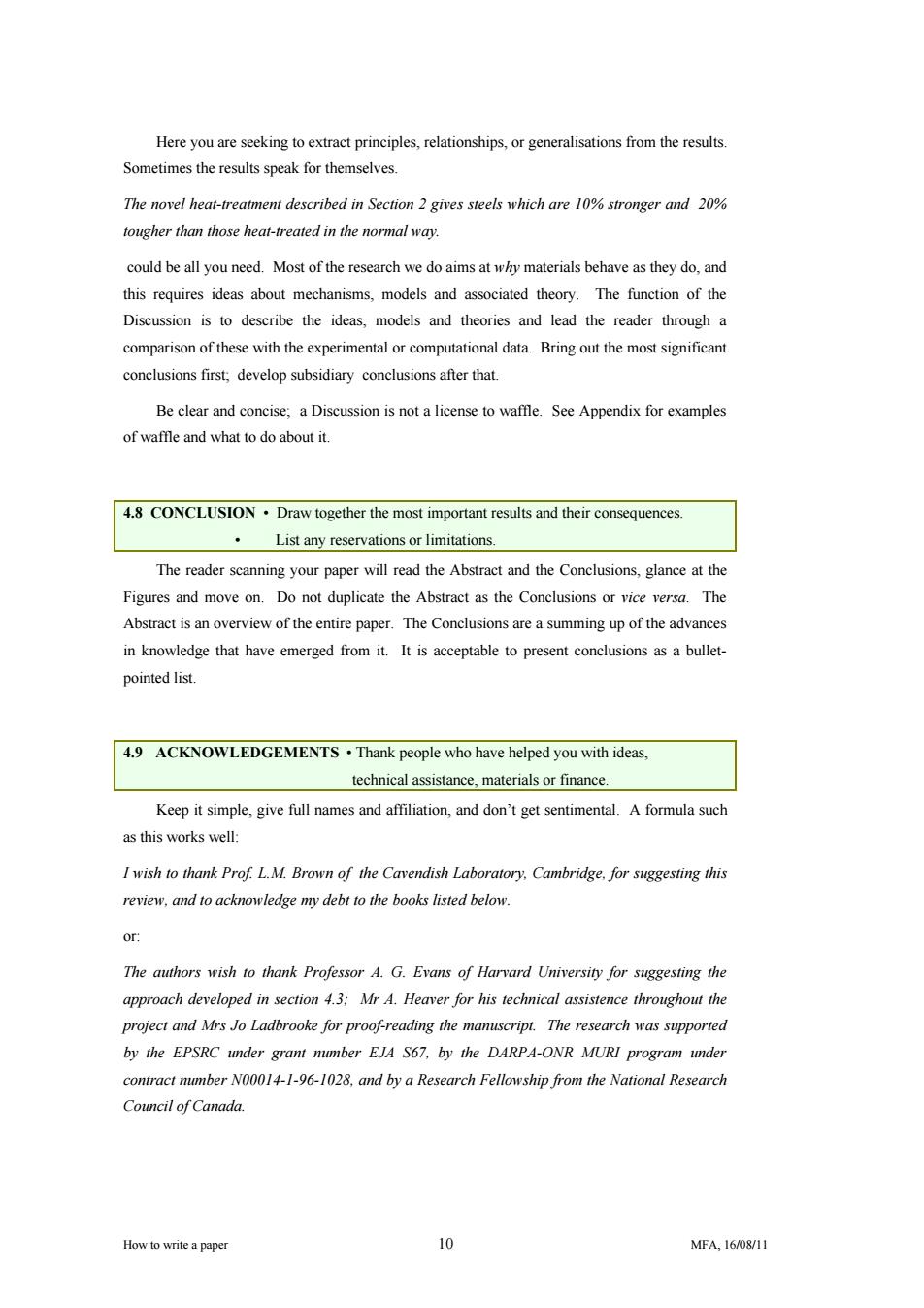正在加载图片...

Here you are seeking to extract principles,relationships,or generalisations from the results. Sometimes the results speak for themselves. The novel heat-treatment described in Section 2 gives steels which are 10%stronger and 20% tougher than those heat-treated in the normal way. could be all you need.Most of the research we do aims at why materials behave as they do,and this requires ideas about mechanisms,models and associated theory.The function of the Discussion is to describe the ideas,models and theories and lead the reader through a comparison of these with the experimental or computational data.Bring out the most significant conclusions first;develop subsidiary conclusions after that. Be clear and concise;a Discussion is not a license to waffle.See Appendix for examples of waffle and what to do about it. 4.8 CONCLUSION.Draw together the most important results and their consequences List any reservations or limitations. The reader scanning your paper will read the Abstract and the Conclusions,glance at the Figures and move on.Do not duplicate the Abstract as the Conclusions or vice versa.The Abstract is an overview of the entire paper.The Conclusions are a summing up of the advances in knowledge that have emerged from it.It is acceptable to present conclusions as a bullet- pointed list. 4.9 ACKNOWLEDGEMENTS.Thank people who have helped you with ideas. technical assistance,materials or finance. Keep it simple,give full names and affiliation,and don't get sentimental.A formula such as this works well: I wish to thank Prof.L.M.Brown of the Cavendish Laboratory,Cambridge,for suggesting this review,and to acknowledge my debt to the books listed below. or: The authors wish to thank Professor A.G.Evans of Harvard University for suggesting the approach developed in section 4.3:Mr A.Heaver for his technical assistence throughout the project and Mrs Jo Ladbrooke for proof-reading the manuscript.The research was supported by the EPSRC under grant number EJA S67,by the DARPA-ONR MURI program under contract number N00014-1-96-1028,and by a Research Fellowship from the National Research Council of Canada. How to write a paper 10 MFA,16/08/11How to write a paper 10 MFA, 16/08/11 Here you are seeking to extract principles, relationships, or generalisations from the results. Sometimes the results speak for themselves. The novel heat-treatment described in Section 2 gives steels which are 10% stronger and 20% tougher than those heat-treated in the normal way. could be all you need. Most of the research we do aims at why materials behave as they do, and this requires ideas about mechanisms, models and associated theory. The function of the Discussion is to describe the ideas, models and theories and lead the reader through a comparison of these with the experimental or computational data. Bring out the most significant conclusions first; develop subsidiary conclusions after that. Be clear and concise; a Discussion is not a license to waffle. See Appendix for examples of waffle and what to do about it. 4.8 CONCLUSION • Draw together the most important results and their consequences. • List any reservations or limitations. The reader scanning your paper will read the Abstract and the Conclusions, glance at the Figures and move on. Do not duplicate the Abstract as the Conclusions or vice versa. The Abstract is an overview of the entire paper. The Conclusions are a summing up of the advances in knowledge that have emerged from it. It is acceptable to present conclusions as a bulletpointed list. 4.9 ACKNOWLEDGEMENTS • Thank people who have helped you with ideas, technical assistance, materials or finance. Keep it simple, give full names and affiliation, and don’t get sentimental. A formula such as this works well: I wish to thank Prof. L.M. Brown of the Cavendish Laboratory, Cambridge, for suggesting this review, and to acknowledge my debt to the books listed below. or: The authors wish to thank Professor A. G. Evans of Harvard University for suggesting the approach developed in section 4.3; Mr A. Heaver for his technical assistence throughout the project and Mrs Jo Ladbrooke for proof-reading the manuscript. The research was supported by the EPSRC under grant number EJA S67, by the DARPA-ONR MURI program under contract number N00014-1-96-1028, and by a Research Fellowship from the National Research Council of Canada